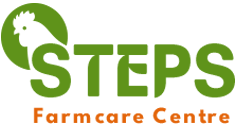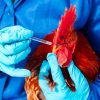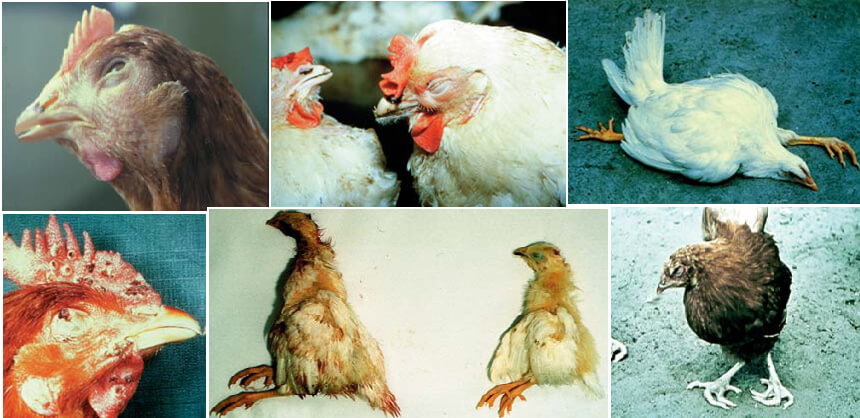
Chicken Infections and Their Symptoms

1. Newcastle Disease (ND)
Newcastle Disease (ND) is a highly contagious viral disease that affects poultry, primarily chickens. It is caused by the Newcastle disease virus (NDV), which belongs to the genus Avulavirus within the family Paramyxoviridae. The virus is enveloped, contains a single-stranded RNA genome, and is classified into three major genotypes: I, II, and III.
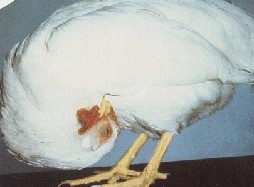
NDV primarily targets the respiratory and nervous systems of poultry. The virus enters the body through the respiratory tract, where it replicates and spreads to other organs. Symptoms of ND can vary depending on the strain of the virus and the age of the affected birds. In general, ND can cause respiratory symptoms such as coughing, sneezing, and nasal discharge. In severe cases, the virus can also cause neurological signs, including tremors, paralysis, and torticollis (twisted neck).
- Cause: Newcastle Disease Virus (NDV)
- Transmission: Direct contact with infected birds, droppings, and contaminated equipment. Airborne transmission can also occur in enclosed spaces.
- Symptoms:
- Respiratory: Coughing, sneezing, nasal discharge, gasping.
- Nervous System: Twisting of the neck, tremors, paralysis of wings/legs.
- Digestive: Greenish, watery diarrhea.
- Production: Drop in egg production, thin-shelled or misshapen eggs.
- Mortality: Can be very high, especially in unvaccinated flocks.
- Treatment: There is no specific treatment for ND. Supportive care includes providing clean water, warmth, and nutrition to affected birds. Antibiotics may be used to prevent secondary bacterial infections.
- Prevention: Vaccination is the most effective preventive measure. Maintaining biosecurity, including quarantine measures, sanitation, and controlling bird movement, helps limit the spread.
| Newcastle Disease | Details |
|---|---|
| Cause | Newcastle Disease Virus (NDV) |
| Transmission | Direct contact, contaminated equipment, aerosols |
| Symptoms | Respiratory distress, nervous disorders, diarrhea |
| Treatment | No specific treatment; supportive care and antibiotics for secondary infections |
| Prevention | Vaccination, biosecurity measures |
NDV is highly contagious and can spread rapidly through a poultry flock. The virus can be transmitted through direct contact with infected birds, their droppings, or contaminated equipment. It can also be spread through the air by infected birds or by contaminated fomites (inanimate objects).
2. Infectious Bronchitis (IB)
It is caused by the infectious bronchitis virus (IBV), which belongs to the genus Coronavirus within the family Coronaviridae. IBV is an enveloped virus with a single-stranded RNA genome and is classified into several different genotypes.
IBV enters the body through the respiratory tract, where it replicates and spreads to other organs. The virus causes inflammation and damage to the trachea, bronchi, and other respiratory tissues. Symptoms of IB can vary depending on the strain of the virus and the age of the affected birds. In general, IB can cause respiratory symptoms such as coughing, sneezing, and nasal discharge. In severe cases, the virus can also lead to decreased egg production, poor growth, and increased mortality rates.
IB is highly contagious and can spread rapidly through a poultry flock. The virus can be transmitted through direct contact with infected birds, their droppings, or contaminated equipment. It can also be spread through the air by infected birds or by contaminated fomites (inanimate objects).

- Cause: Coronavirus
- Transmission: Airborne via aerosols, direct contact with infected birds, and through contaminated equipment, feed, and water.
- Symptoms:
- Respiratory: Coughing, sneezing, nasal discharge, wet eyes.
- Reproductive: Decreased egg production, misshapen eggs, poor-quality shells.
- Growth Issues: Reduced growth in broilers due to decreased feed intake.
- Treatment: No specific treatment for IB. Supportive care includes providing clean water, electrolytes, and maintaining a warm environment. Antibiotics may be administered to manage secondary bacterial infections.
- Prevention: Vaccination is crucial and should be performed at different stages, starting at a day-old. Proper ventilation and biosecurity practices help limit the disease’s spread.
| Infectious Bronchitis | Details |
|---|---|
| Cause | Coronavirus |
| Transmission | Airborne, direct contact, contaminated equipment |
| Symptoms | Respiratory distress, reduced egg production, growth issues |
| Treatment | Supportive care, antibiotics for secondary infections |
| Prevention | Vaccination, biosecurity, ventilation |
Detailed Information: Infectious Bronchitis affects the respiratory tract and reproductive system in chickens, leading to substantial economic losses in both broilers and layers. The disease’s rapid spread necessitates quick action, including isolating infected birds and boosting biosecurity measures. Vaccination, often combined with the Newcastle Disease vaccine, is vital in protecting flocks from IB.
3. Gumboro Disease (Infectious Bursal Disease – IBD)
Gumboro Disease (Infectious Bursal Disease – IBD) is a highly contagious viral disease that primarily affects the bursa of Fabricius, a lymphoid organ in the immune system of poultry. It is caused by the infectious bursal disease virus (IBDV), which belongs to the genus Birnaviridae within the family Birnaviridae. IBDV is a non-enveloped virus with a segmented double-stranded RNA genome and is classified into two major serotypes: classical IBDV (cIBDV) and very virulent IBDV (vvIBDV).
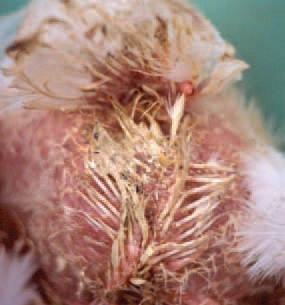
IBDV enters the body through the respiratory tract or by ingestion of contaminated feed or water. The virus replicates in the bursa of Fabricius, causing severe damage to the lymphoid cells. This damage impairs the immune system, making the birds more susceptible to secondary infections. Symptoms of IBD can vary depending on the age of the affected birds and the virulence of the virus. In young chicks, IBD can cause severe diarrhea, ruffled feathers, and poor growth. In older birds, IBD can lead to decreased egg production, poor shell quality, and increased mortality rates.
IB is highly contagious and can spread rapidly through a poultry flock. The virus can be transmitted through direct contact with infected birds, their droppings, or contaminated equipment. It can also be spread through the air by infected birds or by contaminated fomites (inanimate objects)
- Cause: Infectious Bursal Disease Virus (IBDV)
- Transmission: Direct contact with infected birds, contaminated feed, water, litter, and equipment.
- Symptoms:
- Acute Form: Severe depression, ruffled feathers, trembling, reluctance to move.
- Diarrhea: Watery, whitish, or yellowish diarrhea.
- Swollen Bursa: Inflammation and swelling of the bursa, a key immune organ.
- Immune Suppression: Makes chickens more susceptible to other infections.
- Treatment: No specific treatment. Provide supportive care, including hydration and electrolytes. Use antibiotics to control secondary bacterial infections.
- Prevention: Vaccination is essential to prevent Gumboro Disease. Maintaining a clean environment and good biosecurity practices are also crucial.
| Gumboro Disease | Details |
|---|---|
| Cause | Infectious Bursal Disease Virus (IBDV) |
| Transmission | Direct contact, contaminated feed, water, and equipment |
| Symptoms | Depression, diarrhea, swollen bursa |
| Treatment | No specific treatment; supportive care, antibiotics for secondary infections |
| Prevention | Vaccination, biosecurity, sanitation |
Summary: Gumboro Disease primarily targets young chickens, affecting their bursa of Fabricius, an important immune organ. The disease weakens the bird’s immune system, making it vulnerable to other infections. Vaccination at the proper age is critical, as is ensuring cleanliness in the poultry environment to prevent disease spread.
4. Marek’s Disease
Marek’s Disease (MD) is a highly contagious viral disease that affects poultry, primarily chickens. It is caused by the Marek’s disease virus (MDV), which belongs to the genus Alphaherpesvirus within the family Herpesviridae. MDV is an enveloped virus with a double-stranded DNA genome.
MDV enters the body through the respiratory tract or by ingestion of contaminated feed or water. The virus infects T lymphocytes, a type of white blood cell involved in the immune system. MDV can cause tumors in various organs, including the nerves, liver, skin, and eyes. These tumors can lead to paralysis, blindness, and decreased egg production.
MD is highly contagious and can spread rapidly through a poultry flock. The virus can be transmitted through direct contact with infected birds, their droppings, or contaminated equipment. It can also be spread through the air by infected birds or by contaminated fomites (inanimate objects).
- Cause: Herpesvirus
- Transmission: Spread through inhalation of feather dander, dust, and droppings from infected birds.
- Symptoms:
- Nervous System: Paralysis of legs, wings, and neck.
- Tumors: Tumors in organs like the liver, spleen, and kidneys.
- Skin Lesions: Enlarged feather follicles, nodules on the skin.
- Weight Loss: Progressive weight loss, unthriftiness.
- Treatment: No treatment available for Marek’s Disease. Supportive care is often ineffective in severely affected birds.
- Prevention: Vaccination is the only effective method to prevent Marek’s Disease. It is usually given to chicks at the hatchery.
| Marek’s Disease | Details |
|---|---|
| Cause | Herpesvirus |
| Transmission | Inhalation of feather dander, dust, droppings |
| Symptoms | Paralysis, tumors, weight loss |
| Treatment | No treatment; supportive care is limited |
| Prevention | Vaccination at the hatchery |
Summary: Marek’s Disease is a devastating viral infection that leads to paralysis and tumor formation in chickens. The virus remains in the environment through feather dander, making it highly contagious. Vaccination is a critical step in protecting flocks, as once the disease takes hold, it is almost always fatal.
5. Fowl Pox
Fowl pox is a contagious viral disease that affects poultry, primarily chickens. It is caused by the fowl pox virus (FPV), which belongs to the genus Avipoxvirus within the family Poxviridae. FPV is a large, complex virus with a double-stranded DNA genome that is surrounded by a complex envelope.
FPV enters the body through breaks in the skin, such as those caused by scratches or insect bites. The virus replicates at the site of infection, causing the formation of wart-like lesions. These lesions can appear on various parts of the body, including the comb, wattles, eyelids, and skin. In severe cases, FPV can also affect the respiratory tract and the digestive system.
Fowl pox is contagious and can spread rapidly through a poultry flock. The virus can be transmitted through direct contact with infected birds or contaminated equipment. It can also be spread by insects, such as mosquitoes and ticks. While FPV is rarely fatal, it can reduce egg production, impair growth, and cause cosmetic damage to the birds.
- Cause: Avian Poxvirus
- Transmission: Direct contact with infected birds, vectors like mosquitoes, and contaminated equipment.
- Symptoms:
- Cutaneous Form: Wart-like lesions on the comb, wattles, and eyelids.
- Diphtheritic Form: Yellowish plaques in the mouth, throat, and upper respiratory tract.
- Poor Growth: Reduced growth rate and decreased egg production.
- Treatment: No direct treatment. Supportive care includes isolating affected birds and applying antiseptics to lesions. Vaccines can be administered to prevent future outbreaks.
- Prevention: Vaccination at 4-6 weeks of age and vector control (mosquitoes) help prevent infection.
| Fowl Pox | Details |
|---|---|
| Cause | Avian Poxvirus |
| Transmission | Direct contact, mosquito vectors |
| Symptoms | Skin lesions, plaques in mouth/throat |
| Treatment | No direct treatment; supportive care and antiseptics |
| Prevention | Vaccination, mosquito control |
Summary: Fowl Pox is a slow-spreading disease that primarily affects the skin and upper respiratory tract. While mortality is typically low, the condition can lead to poor growth and productivity. Vaccination is the most effective preventive measure, and controlling mosquito populations can reduce transmission. Prevention of fowl pox involves vaccination and good hygiene practices. Vaccines are available to protect poultry against FPV and should be administered according to the recommended schedule. Maintaining clean and sanitized housing, equipment, and feeders can also help to prevent the spread of the virus.
6. Fowl Typhoid
- Cause: Salmonella Gallinarum (a type of Salmonella bacteria)
- Transmission: Ingestion of contaminated feed or water, contact with infected birds, and contaminated equipment. It can also spread vertically from hen to chick.
- Symptoms:
- Lethargy: Listlessness, ruffled feathers, drooping wings.
- Digestive: Yellowish-green diarrhea.
- Physical Appearance: Pale combs and wattles, weight loss.
- Production: Decreased egg production in layers.
- Treatment: Use antibiotics (e.g., oxytetracycline, sulfonamides) under veterinary guidance to reduce mortality and control outbreaks. However, complete eradication of the infection is challenging, as birds can become carriers.
- Prevention: Vaccination and strict biosecurity measures, including cleaning and disinfecting housing, equipment, and ensuring good-quality feed and water.
| Fowl Typhoid | Details |
|---|---|
| Cause | Salmonella Gallinarum |
| Transmission | Contaminated feed/water, infected birds |
| Symptoms | Lethargy, diarrhea, pale combs, decreased egg production |
| Treatment | Antibiotics (under vet guidance) |
| Prevention | Vaccination, biosecurity, sanitation |
Fowl typhoid is caused by the bacterium Salmonella enterica serotype Gallinarum biovar Gallinarum. This bacterium is a gram-negative, non-motile, host-adapted avian pathogen belonging to the Salmonella serogroup D. It is a significant disease affecting poultry, particularly chickens and turkeys, and can cause significant economic losses in commercial poultry production. Chronic infection in adult chickens leads to reduced egg production and carriers that can spread the disease. Strict biosecurity, vaccination, and isolation of infected birds are critical in preventing the disease’s spread.
7. Mycoplasma Gallisepticum (MG) and Mycoplasma Synoviae (MS)
- Cause: Mycoplasma bacteria (Mycoplasma gallisepticum and Mycoplasma synoviae)
- Transmission: Direct contact, airborne droplets, contaminated equipment, and vertical transmission (from hen to chick).
- Symptoms:
- Respiratory: Coughing, sneezing, nasal discharge, and swollen sinuses.
- Joint Issues: Swollen joints and lameness, particularly in M. synoviae infections.
- Egg Production: Decreased egg production, poor eggshell quality.
- Treatment: Antibiotics such as tylosin, erythromycin, or tetracyclines can help manage the symptoms but do not eliminate the bacteria. Affected birds often become carriers.
- Prevention: Vaccination and maintaining a closed flock with good biosecurity practices help control the spread of MG and MS.
| Mycoplasma (MG & MS) | Details |
|---|---|
| Cause | Mycoplasma bacteria |
| Transmission | Airborne droplets, direct contact, vertical transmission |
| Symptoms | Respiratory distress, swollen joints, decreased egg production |
| Treatment | Antibiotics (e.g., tylosin, tetracyclines) |
| Prevention | Vaccination, biosecurity, closed flock |
Summary: Mycoplasma infections are chronic in nature, often leading to recurring respiratory problems and decreased productivity in poultry. These infections can weaken the birds’ resistance to other diseases. While antibiotics can alleviate symptoms, they do not eradicate the bacteria, making biosecurity and vaccination key preventive measures.
8. Infectious Laryngotracheitis (ILT)
- Cause: Herpesvirus
- Transmission: Direct contact with infected birds, contaminated equipment, and airborne droplets.
- Symptoms:
- Respiratory Distress: Gasping for air, coughing, nasal discharge, and blood-tinged mucus from the beak.
- Depression: Reduced appetite and poor growth.
- Mortality: High in severe outbreaks, particularly if not managed promptly.
- Treatment: No specific treatment. Supportive care includes keeping birds warm, providing clean water, and managing secondary infections with antibiotics.
- Prevention: Vaccination is the primary preventive method. Maintain biosecurity measures to limit exposure to infected birds and contaminated equipment.
| Infectious Laryngotracheitis | Details |
|---|---|
| Cause | Herpesvirus |
| Transmission | Airborne droplets, direct contact |
| Symptoms | Gasping, coughing, blood-tinged mucus |
| Treatment | Supportive care, antibiotics for secondary infections |
| Prevention | Vaccination, biosecurity |
Summary: ILT primarily targets the respiratory tract, leading to significant distress and potential mortality in poultry flocks. The disease spreads rapidly in high-density flocks. Vaccination, often administered as an eye drop, is effective in preventing ILT outbreaks. Ensuring good ventilation and biosecurity helps minimize the disease’s impact.
9. Avian Influenza (AI)
- Cause: Avian Influenza Virus (Type A)
- Transmission: Direct contact with infected birds, airborne droplets, contaminated equipment, and water sources. Migratory wild birds are common carriers of the virus, which can spread to domestic poultry.
- Symptoms:
- Respiratory: Sneezing, coughing, nasal discharge, swollen sinuses.
- Digestive: Diarrhea.
- Neurological: Twisting of the neck, paralysis, incoordination.
- Production: Drop in egg production and misshapen eggs.
- Treatment: No specific treatment for Avian Influenza. In the event of an outbreak, affected birds are often culled to prevent further spread. Supportive care may help reduce symptoms in mild cases.
- Prevention: Strict biosecurity measures, including isolation of infected birds and sanitation, are crucial. Vaccination may be used in some regions under the guidance of veterinary authorities. Preventing contact between domestic poultry and wild birds is key.
| Avian Influenza | Details |
|---|---|
| Cause | Avian Influenza Virus (Type A) |
| Transmission | Direct contact, airborne droplets, contaminated equipment |
| Symptoms | Respiratory distress, diarrhea, neurological signs |
| Treatment | No specific treatment; culling in severe outbreaks |
| Prevention | Biosecurity, vaccination (region-specific), control of wild bird contact |
Detailed Information: Avian Influenza is a highly contagious viral disease with different strains varying in severity. Highly pathogenic forms can lead to sudden death in poultry, whereas low pathogenic forms might only cause mild symptoms. Due to its zoonotic potential (it can sometimes infect humans), Avian Influenza outbreaks often result in trade restrictions and economic losses. Immediate reporting to authorities and quarantine of the affected area are crucial steps in managing outbreaks.
10. Salmonella Infection
- Cause: Salmonella species (e.g., Salmonella Enteritidis, Salmonella Typhimurium)
- Transmission: Spread through contaminated feed, water, and feces. It can also be transmitted vertically from infected hens to eggs.
- Symptoms:
- Lethargy: Listlessness, huddling, reduced feed intake.
- Digestive: Yellowish-green diarrhea.
- Dehydration: Sunken eyes, poor growth.
- Egg Contamination: Bacteria can contaminate eggs, posing a risk to human health.
- Treatment: Antibiotics (e.g., amoxicillin, enrofloxacin) can help manage symptoms, but resistance is a concern. Supportive care, including hydration and electrolytes, is important. Strict culling of carriers may be necessary.
- Prevention: Proper biosecurity, good hygiene, vaccination, and feeding high-quality, uncontaminated feed. Implement rodent and pest control, as these can be vectors for the bacteria.
| Salmonella Infection | Details |
|---|---|
| Cause | Salmonella species |
| Transmission | Contaminated feed, water, feces, vertical transmission |
| Symptoms | Diarrhea, lethargy, dehydration, egg contamination |
| Treatment | Antibiotics, supportive care |
| Prevention | Biosecurity, vaccination, hygiene, rodent control |
Detailed Information: Salmonella infections in poultry not only impact flock health but also pose a significant food safety risk to humans. Infected birds can become carriers, shedding the bacteria in their droppings, which can then contaminate eggs and meat. Vaccination programs, proper sanitation, and thorough cooking of poultry products are effective strategies for managing Salmonella.
Preventing Common Chicken Infections
To ensure the health of your flock, it’s essential to take proactive measures to prevent infections:
1. Biosecurity Measures
- Quarantine: Isolate new birds for a period before introducing them to your flock to prevent disease transmission.
- Hygiene: Keep chicken housing, equipment, and feeders clean and sanitized to reduce the risk of infections.
- Visitor Control: Limit access to your poultry area to prevent outside contamination.
- Rodent and Pest Control: Control rodents and other pests that may carry diseases.
2. Proper Nutrition
- Balanced Diet: Provide your chickens with a high-quality, balanced diet that supports their immune systems.
- Clean Water: Ensure fresh and clean water is always available to avoid contamination.
3. Vaccination
- Regular Vaccination: Follow a recommended vaccination schedule tailored to the diseases prevalent in your area.
- Veterinary Consultation: Consult with a veterinarian to determine which vaccines are necessary for your specific flock.
4. Environmental Factors
- Ventilation: Maintain proper airflow in the chicken coop to reduce respiratory disease risks.
- Temperature Control: Ensure chickens are comfortable by providing adequate heat in colder weather and cooling measures in hot climates.
- Stress Reduction: Minimize stress caused by overcrowding, sudden changes, or predators, as stress can lower chickens’ immunity.
5. Regular Check-ups
- Monitor Your Flock: Regularly inspect chickens for signs of illness or behavioral changes.
- Veterinary Care: Seek veterinary assistance as soon as you notice any signs of illness to prevent further complications.
6. Hygiene Practices
- Clean Feeders and Waterers: Clean feeders and waterers regularly to prevent bacterial contamination.
- Sanitation: Regularly disinfect chicken housing and equipment to remove pathogens.
- Waste Disposal: Properly dispose of chicken droppings to minimize disease transmission.
References:
Disclaimer
The information provided here is intended for educational purposes only and is not a substitute for professional veterinary advice. Chicken infections can vary in severity and presentation, and proper diagnosis, treatment, and management require consultation with a qualified veterinarian. It is crucial to seek expert guidance for specific health concerns and to develop a tailored vaccination and health plan suited to your flock and regional disease prevalence. While every effort has been made to provide accurate and up-to-date information, the complexities of poultry health mean that ongoing veterinary consultation and disease surveillance are essential.
